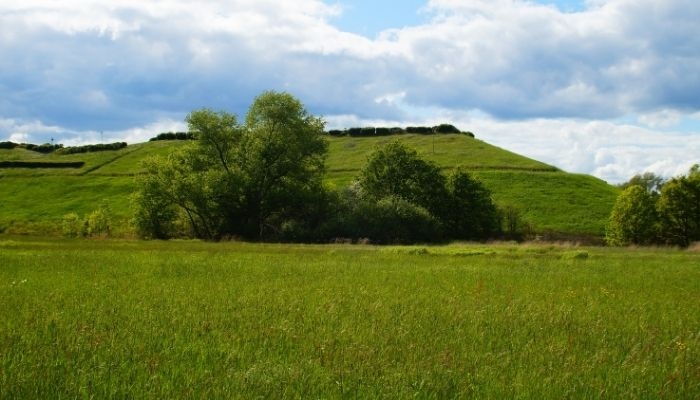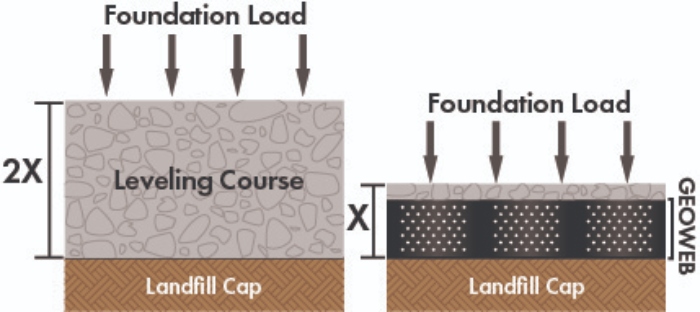By Michael J. Dickey, P.E., director, Presto GeoSystems
Presto GeoSystems asserts the GEOWEB Soil Stabilization System incorporates effective geocells for redevelopment of closed landfills.

Redevelopment of closed landfills and capped solid waste sites represent a unique opportunity for landfill owners, solar developer, and communities to work together to put underutilized properties back into productive use. Moreover, many such sites are conveniently located near existing transmission infrastructure and may be easier and more economical from an interconnection standpoint than rural greenfield sites.
However, building over a closed landfill poses unique challenges because most landfills are covered by an engineered cap not typically designed to support loads from permanent foundations or heavy equipment. Additionally, state and federal regulations generally prohibit any activity that could potentially breach or damage the cap. Therefore, retrofitting a closed landfill for utility-scale or community solar projects requires careful planning. Ultimately, the project must not jeopardize the intent of the original cap design; that is, to protect human health and the environment.
Selecting suitable foundation geocells for redevelopment of closed landfills
Concrete slabs and pre-cast ballast footings are both foundation options for solar system installations on landfill caps. In general, concrete slab foundations are heavier than ballast footings and pose a higher risk of creating landfill settlement and side-slope stability issues. Ballasted footings are a lighter-weight option and may be suitable for flat landfill surfaces; however, engineering difficulties emerge as the slope of the landfill surface increases. Ultimately, the foundation must be designed to protect the system against wind uplift and sliding without exceeding the allowable bearing capacity of the cap.
Allowable bearing capacity is site specific and is typically a function of cap thickness and composition, combined with appropriate considerations to account for the makeup and age of the underlying waste material. For example, old construction debris that has been previously compacted will not experience significant settlement because of low biochemical degradation; therefore, the likelihood for damage to the cap, or the solar installation, can be expected to be relatively low. Conversely, a thin cap over a relatively new landfill cell containing unconsolidated municipal waste, which would see short- and long-term settlement, may be at a much higher risk of damage, and any new construction may therefore be subject to a much lower allowable bearing capacity requirement.
There are methods to improve bearing capacity and mitigate settlement for new developments on previously closed landfills. Geosynthetics can be employed to dissipate loads from foundations and construction equipment and provide long-term protection against the damaging effects of differential settlement. Geocells for redevelopment on closed landfills can be integrated into the leveling course beneath ballast footings or the base layer beneath a concrete slab to improve the allowable bearing capacity and protect solar foundations from cracking and settlement problems.
Improving allowable bearing capacity and protecting against differential settlement
Geocells—recognizable by their unique 3D honeycomb-shaped appearance—are a specialized geosynthetic material widely used in construction for load support, slope/channel protection, erosion control and mechanically stabilized earth (MSE) walls. Compared to planar geosynthetic products such as geogrids—which commonly rely on expensive imported high-quality aggregate—geocells are highly versatile and can be filled with a variety of commonly available and economical infill materials. Compatible infill materials include sand, soil, aggregate, concrete, pulverized debris, recycled asphalt or other locally sourced materials.

With geocells, it is not uncommon to see an overall reduction in the required thickness of the base layer or leveling course in a load support application by 50% or more, along with an overall improvement in allowable bearing capacity. This applies to foundations as well as permanent or temporary site features, such as access roads or construction platforms.
In load-support applications, when a static or dynamic load is applied to a geocell-reinforced layer, lateral earth pressures are mobilized and transferred across a 3D network of interconnected cells. The layer essentially performs like a composite material, facilitating a phenomenon known as the mattress effect. As a result, applied loads are more widely spread, resulting in a uniform distribution of applied stresses, as well as a reduction in the magnitude of these stresses to underlying layers. This results in an effective increase in the allowable bearing capacity and a reduction in differential settlement.
In load-support applications, when a static or dynamic load is applied to a geocell-reinforced layer, lateral earth pressures are mobilized and transferred across a 3D network of interconnected cells. The layer essentially performs like a composite material, facilitating a phenomenon known as the mattress effect.
Moreover, in many cases, geocells allow for the beneficial reuse of on-site materials, eliminating the need to purchase expensive aggregate or imported structural fill. These advantages not only offer the potential for savings in overall construction costs, but they also contribute to a significant reduction in carbon emissions due to less aggregate/fill processing, transportation and handling.
Geocells for redevelopment of solar sites
GEOWEB Geocells have been used for load support and foundation applications worldwide for more than 40 years. Developed in collaboration with the U.S. Army Corps of Engineers in the late 1970s, Presto co-invented the technology known today as geocells. Since that time, Presto has endeavored to improve and innovate geocell technology, creating what is known as the GEOWEB Soil Stabilization System. This geocell system is made of 100% high-density virgin polyethylene and do not contain any recycled material, fillers or exotic polymer, all of which can negatively affect performance. Complete with a full line of accessories for ease of installation and long-term performance, the system represents advanced geocell technology.

The system has been used on every continent and on thousands of load support, slope stabilization, channel protection and retaining wall projects. Based on accredited third-party laboratory analysis using internationally recognized test methods, GEOWEB geocells are predicted to be durable for a minimum of 50 years and are resistant to long-term weathering and UV degradation.
This article originally appeared on the Presto GeoSystems blog.
 TEXTILES.ORG
TEXTILES.ORG


